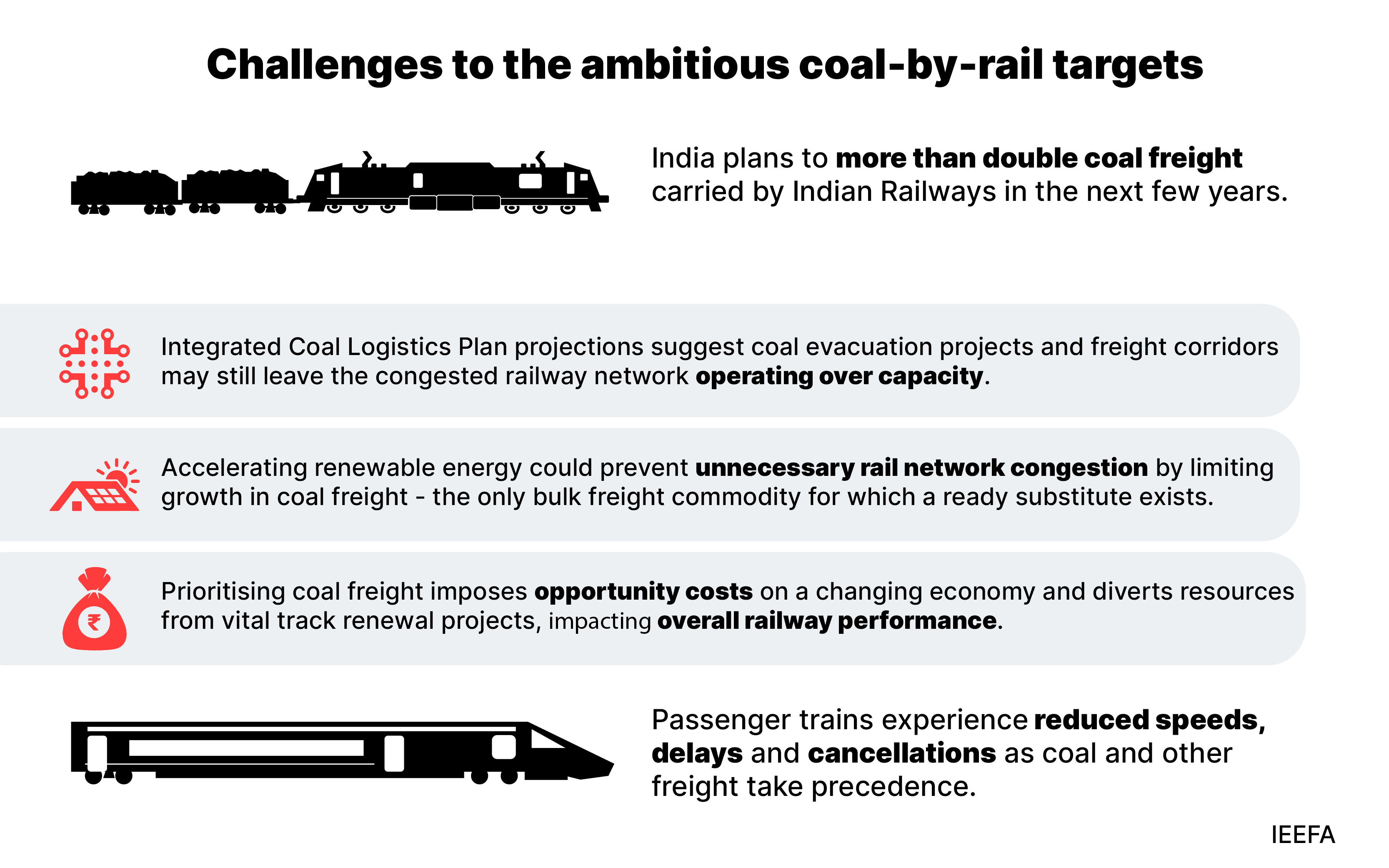Ambitious coal transportation plans will place a further strain on Indian Railways

Transporting an additional 400 million tonnes of coal by rail in coming years will constrain the ability of the Indian Railways to undertake vital network upgrades and better serve other freight and passenger demands.
Key Takeaways:
India’s plans for expanding coal freight by rail face congestion and logistical challenges despite the commissioning of the Eastern Dedicated Freight Corridor, diverting resources from vital network upgrades and imposing opportunity costs on a growing economy.
Accelerating clean energy and recognising coal’s network congestion effects can enable the Indian Railways to better serve India’s changing economic needs, including fast and reliable passenger services and alternative types of freight. Renewable energy projects should be prioritised and incentivised in regions where thermal power plants are far from India’s coal mines.
Non-suburban trains are serving fewer passengers than in 2019 at the slowest speeds since 2015, signifying the return of rail network congestion, a chronic problem that will only be exacerbated if coal freight is more than doubled.
Investments in coal evacuation infrastructure also pose a long-term stranded asset risk since these are coming up in some of India’s least populated areas. Railway infrastructure planning should be continuously updated to take account of new renewable generation goals.
Indian Railways can better utilise its resources and serve the Indian economy more effectively if policymakers focus on accelerating renewable energy generation rather than expanding coal freight by rail, a new report by the Institute for Energy Economics and Financial Analysis (IEEFA) finds.
The report analyses various forecasts by different agencies of the Indian government and finds that there are plans to increase coal freight transported by rail by at least 400 million tonnes in the next eight years. To meet the target, a range of rail infrastructure projects, including the recently opened Eastern Dedicated Freight Corridor, are imminent or ongoing. The authorities are actively considering more such projects.
“The prioritisation of coal freight presents opportunity costs for the Indian Railways and the nation more broadly. A renewed focus by policymakers on generating more electricity from renewable sources and moving it over wires rather than in the form of coal would help the Indian Railways play a more effective role in India’s changing economy,” says the report’s author, Charles Worringham, Guest Contributor, IEEFA.
The report recommends that railway infrastructure planning should be continuously updated to take account of new renewable generation goals and improved electricity demand outlooks to better forecast actual future coal freight requirements.
Further, the report highlights that apart from financial resources, developing coal evacuation infrastructure diverts the Indian Railways’ human and physical resources. The sheer number of projects centred on coal, as well as the Mumbai-Ahmedabad bullet train project, reduces the availability of planning, design, project management, engineering, equipment and materials for basic maintenance and upgrade work on the general network.
This is particularly concerning as network congestion issues are cropping up again for the Indian Railways, according to the report’s analysis of recent data. The report finds that the Railways is carrying higher freight loads than in 2019, but freight train speeds are at similar levels. Secondly, non-suburban passenger bookings are at 83% of 2019 levels, even though passenger train speeds have been lower than any month since June 2015. Thirdly, during coal supply crises, passenger trains have been cancelled to prioritise coal movement. Finally, wagon turnaround times have also been increasing.
“In an expanding and changing economy, transporting raw materials, refrigerated food and finished goods, and enhanced passenger services require network capacity. These services could face significant constraints due to coal freight expansion, which would also worsen the trend of roads increasing their modal share. says Worringham.
The report recommends prioritising and incentivising new renewable energy generation projects in regions where thermal power plants are far from India’s coal regions.
“Long distances have a disproportionately negative effect on railway network congestion and make a far larger call on railway resources,” says Worringham.
The report also highlights stranded asset risk as one of the key concerns of Indian Railways’ investments in coal evacuation projects.
“Most of the coal evacuation infrastructure is coming up in India’s least populated areas. As electricity generation from renewable sources ramps up further and the demand for coal declines in the coming decades, there may not be enough new freight in the coal-bearing regions to justify the Indian Railways’ capital expenditure outlay,” says Worringham.
“To minimise stranded asset risks, all specific potential new railway infrastructure called for in the Integrated Coal Logistics Plan should be re-evaluated, using realistic estimates of project completion timelines and probable project costs, and take account of India’s energy transition progress in coming decades,” he adds.
Read the report: Coal: A Heavy Burden on the Indian Railways
Media contact: Prionka Jha ([email protected]) Ph: +91 9818884854
Author contacts: Charles Worringham ([email protected])
About IEEFA: The Institute for Energy Economics and Financial Analysis (IEEFA) examines issues related to energy markets, trends, and policies. The Institute’s mission is to accelerate the transition to a diverse, sustainable and profitable energy economy. (ieefa.org)











